Zhenwen Liang
DeepMath-103K: A Large-Scale, Challenging, Decontaminated, and Verifiable Mathematical Dataset for Advancing Reasoning
Apr 15, 2025Abstract:The capacity for complex mathematical reasoning is a key benchmark for artificial intelligence. While reinforcement learning (RL) applied to LLMs shows promise, progress is significantly hindered by the lack of large-scale training data that is sufficiently challenging, possesses verifiable answer formats suitable for RL, and is free from contamination with evaluation benchmarks. To address these limitations, we introduce DeepMath-103K, a new, large-scale dataset comprising approximately 103K mathematical problems, specifically designed to train advanced reasoning models via RL. DeepMath-103K is curated through a rigorous pipeline involving source analysis, stringent decontamination against numerous benchmarks, and filtering for high difficulty (primarily Levels 5-9), significantly exceeding existing open resources in challenge. Each problem includes a verifiable final answer, enabling rule-based RL, and three distinct R1-generated solutions suitable for diverse training paradigms like supervised fine-tuning or distillation. Spanning a wide range of mathematical topics, DeepMath-103K promotes the development of generalizable reasoning. We demonstrate that models trained on DeepMath-103K achieve significant improvements on challenging mathematical benchmarks, validating its effectiveness. We release DeepMath-103K publicly to facilitate community progress in building more capable AI reasoning systems: https://github.com/zwhe99/DeepMath.
MMVU: Measuring Expert-Level Multi-Discipline Video Understanding
Jan 21, 2025



Abstract:We introduce MMVU, a comprehensive expert-level, multi-discipline benchmark for evaluating foundation models in video understanding. MMVU includes 3,000 expert-annotated questions spanning 27 subjects across four core disciplines: Science, Healthcare, Humanities & Social Sciences, and Engineering. Compared to prior benchmarks, MMVU features three key advancements. First, it challenges models to apply domain-specific knowledge and perform expert-level reasoning to analyze specialized-domain videos, moving beyond the basic visual perception typically assessed in current video benchmarks. Second, each example is annotated by human experts from scratch. We implement strict data quality controls to ensure the high quality of the dataset. Finally, each example is enriched with expert-annotated reasoning rationals and relevant domain knowledge, facilitating in-depth analysis. We conduct an extensive evaluation of 32 frontier multimodal foundation models on MMVU. The latest System-2-capable models, o1 and Gemini 2.0 Flash Thinking, achieve the highest performance among the tested models. However, they still fall short of matching human expertise. Through in-depth error analyses and case studies, we offer actionable insights for future advancements in expert-level, knowledge-intensive video understanding for specialized domains.
SaSR-Net: Source-Aware Semantic Representation Network for Enhancing Audio-Visual Question Answering
Nov 07, 2024



Abstract:Audio-Visual Question Answering (AVQA) is a challenging task that involves answering questions based on both auditory and visual information in videos. A significant challenge is interpreting complex multi-modal scenes, which include both visual objects and sound sources, and connecting them to the given question. In this paper, we introduce the Source-aware Semantic Representation Network (SaSR-Net), a novel model designed for AVQA. SaSR-Net utilizes source-wise learnable tokens to efficiently capture and align audio-visual elements with the corresponding question. It streamlines the fusion of audio and visual information using spatial and temporal attention mechanisms to identify answers in multi-modal scenes. Extensive experiments on the Music-AVQA and AVQA-Yang datasets show that SaSR-Net outperforms state-of-the-art AVQA methods.
Improving LLM Reasoning through Scaling Inference Computation with Collaborative Verification
Oct 05, 2024Abstract:Despite significant advancements in the general capability of large language models (LLMs), they continue to struggle with consistent and accurate reasoning, especially in complex tasks such as mathematical and code reasoning. One key limitation is that LLMs are trained primarily on correct solutions, reducing their ability to detect and learn from errors, which hampers their ability to reliably verify and rank outputs. To address this, we scale up the inference-time computation by generating multiple reasoning paths and employing verifiers to assess and rank the generated outputs by correctness. To facilitate this, we introduce a comprehensive dataset consisting of correct and incorrect solutions for math and code tasks, generated by multiple LLMs. This diverse set of solutions enables verifiers to more effectively distinguish and rank correct answers from erroneous outputs. The training methods for building verifiers were selected based on an extensive comparison of existing approaches. Moreover, to leverage the unique strengths of different reasoning strategies, we propose a novel collaborative method integrating Chain-of-Thought (CoT) and Program-of-Thought (PoT) solutions for verification. CoT provides a clear, step-by-step reasoning process that enhances interpretability, while PoT, being executable, offers a precise and error-sensitive validation mechanism. By taking both of their strengths, our approach significantly improves the accuracy and reliability of reasoning verification. Our verifiers, Math-Rev and Code-Rev, demonstrate substantial performance gains to existing LLMs, achieving state-of-the-art results on benchmarks such as GSM8k and MATH and even outperforming GPT-4o with Qwen-72B-Instruct as the reasoner.
Learning Molecular Representation in a Cell
Jun 17, 2024Abstract:Predicting drug efficacy and safety in vivo requires information on biological responses (e.g., cell morphology and gene expression) to small molecule perturbations. However, current molecular representation learning methods do not provide a comprehensive view of cell states under these perturbations and struggle to remove noise, hindering model generalization. We introduce the Information Alignment (InfoAlign) approach to learn molecular representations through the information bottleneck method in cells. We integrate molecules and cellular response data as nodes into a context graph, connecting them with weighted edges based on chemical, biological, and computational criteria. For each molecule in a training batch, InfoAlign optimizes the encoder's latent representation with a minimality objective to discard redundant structural information. A sufficiency objective decodes the representation to align with different feature spaces from the molecule's neighborhood in the context graph. We demonstrate that the proposed sufficiency objective for alignment is tighter than existing encoder-based contrastive methods. Empirically, we validate representations from InfoAlign in two downstream tasks: molecular property prediction against up to 19 baseline methods across four datasets, plus zero-shot molecule-morphology matching.
Learn Beyond The Answer: Training Language Models with Reflection for Mathematical Reasoning
Jun 17, 2024



Abstract:Supervised fine-tuning enhances the problem-solving abilities of language models across various mathematical reasoning tasks. To maximize such benefits, existing research focuses on broadening the training set with various data augmentation techniques, which is effective for standard single-round question-answering settings. Our work introduces a novel technique aimed at cultivating a deeper understanding of the training problems at hand, enhancing performance not only in standard settings but also in more complex scenarios that require reflective thinking. Specifically, we propose reflective augmentation, a method that embeds problem reflection into each training instance. It trains the model to consider alternative perspectives and engage with abstractions and analogies, thereby fostering a thorough comprehension through reflective reasoning. Extensive experiments validate the achievement of our aim, underscoring the unique advantages of our method and its complementary nature relative to existing augmentation techniques.
MathChat: Benchmarking Mathematical Reasoning and Instruction Following in Multi-Turn Interactions
May 29, 2024



Abstract:Large language models (LLMs) have demonstrated impressive capabilities in mathematical problem solving, particularly in single turn question answering formats. However, real world scenarios often involve mathematical question answering that requires multi turn or interactive information exchanges, and the performance of LLMs on these tasks is still underexplored. This paper introduces MathChat, a comprehensive benchmark specifically designed to evaluate LLMs across a broader spectrum of mathematical tasks. These tasks are structured to assess the models' abilities in multiturn interactions and open ended generation. We evaluate the performance of various SOTA LLMs on the MathChat benchmark, and we observe that while these models excel in single turn question answering, they significantly underperform in more complex scenarios that require sustained reasoning and dialogue understanding. To address the above limitations of existing LLMs when faced with multiturn and open ended tasks, we develop MathChat sync, a synthetic dialogue based math dataset for LLM finetuning, focusing on improving models' interaction and instruction following capabilities in conversations. Experimental results emphasize the need for training LLMs with diverse, conversational instruction tuning datasets like MathChatsync. We believe this work outlines one promising direction for improving the multiturn mathematical reasoning abilities of LLMs, thus pushing forward the development of LLMs that are more adept at interactive mathematical problem solving and real world applications.
Defending Jailbreak Prompts via In-Context Adversarial Game
Feb 20, 2024
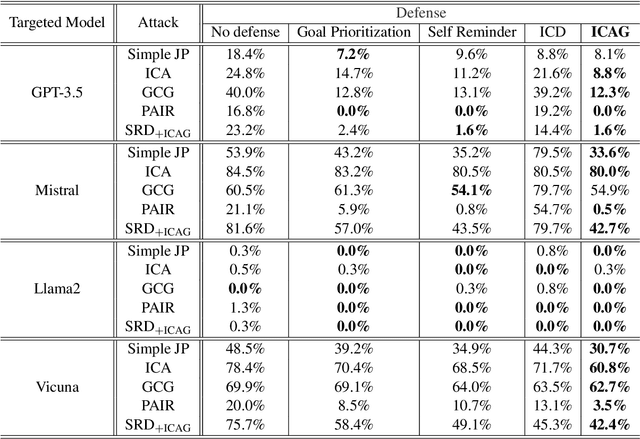

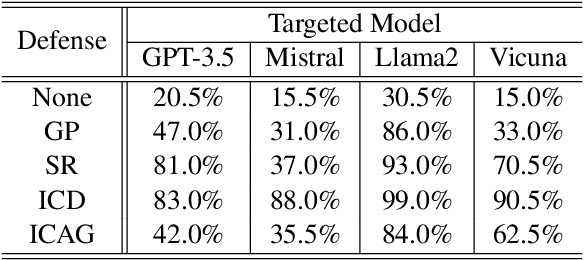
Abstract:Large Language Models (LLMs) demonstrate remarkable capabilities across diverse applications. However, concerns regarding their security, particularly the vulnerability to jailbreak attacks, persist. Drawing inspiration from adversarial training in deep learning and LLM agent learning processes, we introduce the In-Context Adversarial Game (ICAG) for defending against jailbreaks without the need for fine-tuning. ICAG leverages agent learning to conduct an adversarial game, aiming to dynamically extend knowledge to defend against jailbreaks. Unlike traditional methods that rely on static datasets, ICAG employs an iterative process to enhance both the defense and attack agents. This continuous improvement process strengthens defenses against newly generated jailbreak prompts. Our empirical studies affirm ICAG's efficacy, where LLMs safeguarded by ICAG exhibit significantly reduced jailbreak success rates across various attack scenarios. Moreover, ICAG demonstrates remarkable transferability to other LLMs, indicating its potential as a versatile defense mechanism.
Chain-of-Layer: Iteratively Prompting Large Language Models for Taxonomy Induction from Limited Examples
Feb 12, 2024Abstract:Automatic taxonomy induction is crucial for web search, recommendation systems, and question answering. Manual curation of taxonomies is expensive in terms of human effort, making automatic taxonomy construction highly desirable. In this work, we introduce Chain-of-Layer which is an in-context learning framework designed to induct taxonomies from a given set of entities. Chain-of-Layer breaks down the task into selecting relevant candidate entities in each layer and gradually building the taxonomy from top to bottom. To minimize errors, we introduce the Ensemble-based Ranking Filter to reduce the hallucinated content generated at each iteration. Through extensive experiments, we demonstrate that Chain-of-Layer achieves state-of-the-art performance on four real-world benchmarks.
SceMQA: A Scientific College Entrance Level Multimodal Question Answering Benchmark
Feb 06, 2024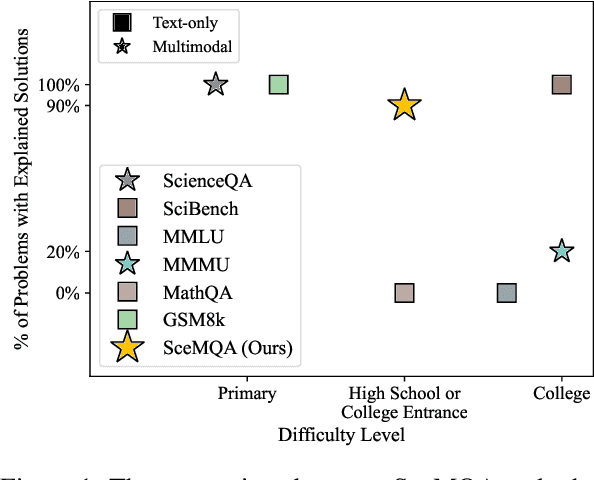

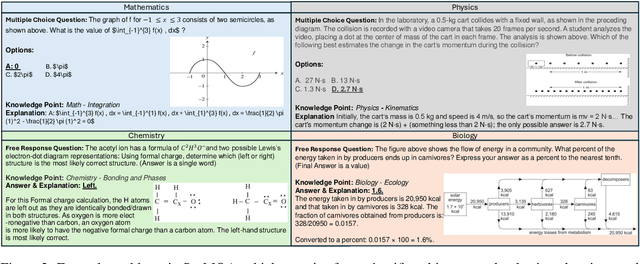
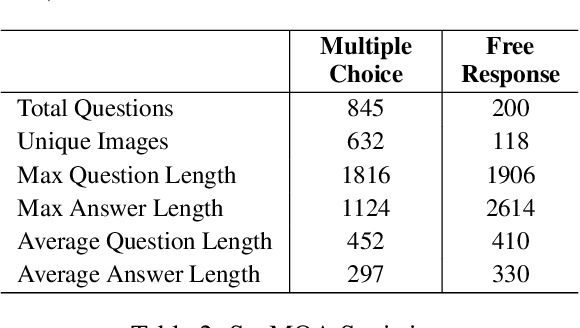
Abstract:The paper introduces SceMQA, a novel benchmark for scientific multimodal question answering at the college entrance level. It addresses a critical educational phase often overlooked in existing benchmarks, spanning high school to pre-college levels. SceMQA focuses on core science subjects including Mathematics, Physics, Chemistry, and Biology. It features a blend of multiple-choice and free-response formats, ensuring a comprehensive evaluation of AI models' abilities. Additionally, our benchmark provides specific knowledge points for each problem and detailed explanations for each answer. SceMQA also uniquely presents problems with identical contexts but varied questions to facilitate a more thorough and accurate assessment of reasoning capabilities. In the experiment, we evaluate both open-source and close-source state-of-the-art Multimodal Large Language Models (MLLMs), across various experimental settings. The results show that further research and development are needed in developing more capable MLLM, as highlighted by only 50% to 60% accuracy achieved by the strongest models. Our benchmark and analysis will be available at https://scemqa.github.io/
 Add to Chrome
Add to Chrome Add to Firefox
Add to Firefox Add to Edge
Add to Edge